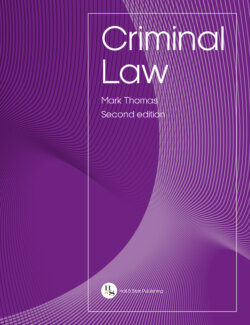Читать книгу Criminal Law - Mark Thomas - Страница 112
Development
ОглавлениеPrior to Kennedy (No 2), the law was in a state of flux with contrasting authorities and tests to be applied.
To begin with, the classic pronouncement of the Kennedy (No 2) test in operation today is the case of R v Latif; R v Shahzad [1996] 1 All ER 353. In Latif, the defendants intended to import heroin from Pakistan into the UK. Unbeknownst to the defendants, the drugs were flown to Britain by a British customs officer whilst the defendants were arrested in London. The House of Lords held that the actions of the customs officer broke the chain of causation as his actions of flying the drugs into the jurisdiction were ‘free, deliberate and informed’. Lord Steyn commented that ‘the general principle is that the free, deliberate and informed intervention of a second person, who intends to exploit the situation created by the first, but is not acting in concert with him, is held to relieve the first actor of criminal responsibility’. Importantly, although the defendants were not liable for importing the drugs, they were still liable for attempting to do so.
One can contrast the facts of this case with that of R v Jakeman (1982) 76 Cr App R 223, where the defendant booked suitcases containing drugs onto a series of flights to London. The defendant got cold feet and abandoned the suitcases in Paris. The cases, however, were still sent on to London where the drugs were eventually discovered. Although novus actus interveniens was not an issue in that case, it is clear that the actions of the defendant were still the substantial and operating cause, and no action on the part of the airport officials would break the chain of causation as their actions would not have been ‘free, deliberate and informed’. Jakeman and the more recent case of R v Styles [2015] EWCA Crim 1619 will be discussed in greater detail in Chapter 3.
In 1999 came the controversial authority of Empress Car Co (Abertillery) Ltd v National Rivers Authority [1999] 2 AC 22 (Empress Cars), which operated in direct conflict with the decision in Latif.
case example
Charge: Polluting controlled waters (Water Resources Act 1991, s 85)
Case progression: Crown Court – Guilty
Court of Appeal – Conviction upheld
House of Lords – Conviction upheld
Point of law: Legal causation in pollution cases
In Empress Car Co (Abertillery) Ltd v National Rivers Authority [1999] 2 AC 22, the defendant stored oil on its site. During the night, X (an unidentified stranger) released the oil into a watercourse as an act of vandalism. It was learned that the defendant had failed to take precautions to prevent acts of vandalism, or to restrict the subsequent release of fuel from the tap.
The issue before the House of Lords was whether the act of the third party broke the chain of causation. The third party’s actions were clearly ‘free, deliberate and informed’; however, the Lords held this to be the wrong principle. Rather, according to Lord Hoffmann, the question to be asked was whether the third party’s act was a ‘normal fact of life or something extraordinary’. Their Lordships held this case to be an example of the former and ruled that the chain of causation was not broken. The defendant company remained liable.
Justifying it on policy grounds, the Lords effectively created confusion in the law with the lower courts unsure as to which authority to follow: Latif or Empress Cars? Thankfully, the House of Lords in R v Kennedy (No 2) [2008] 1 AC 269 clarified the legal position of the Empress Cars precedent. Lord Bingham made clear that, although the House did not wish ‘to throw any doubt’ on the Empress Cars authority, it ought to be restricted to facts involving environmental offences (see R (Natural England) v Day [2014] EWCA Crim 2683 for an affirmation of this). As a result, therefore, in all cases, other than pollution cases, involving the act of a third party, the test to be applied is that in Latif. Upon the statement in Kennedy, Ashworth (Principles of Criminal Law, 6th edn (OUP, 2009)) helpfully restated the principle of Latif, namely that
voluntary conduct acts as a barrier in any causal enquiry in criminal law; by and large, D’s voluntary conduct will usually be regarded as the cause of an act or omission if it was the last human conduct before the result.
Therefore, we can now be settled in our minds that the act of a third party will only break the chain of causation in circumstances where it is ‘free, deliberate and informed’ and the defendant is no longer the ‘substantial and operating’ cause. However, what exactly do these phrases mean? We shall consider each in turn.
